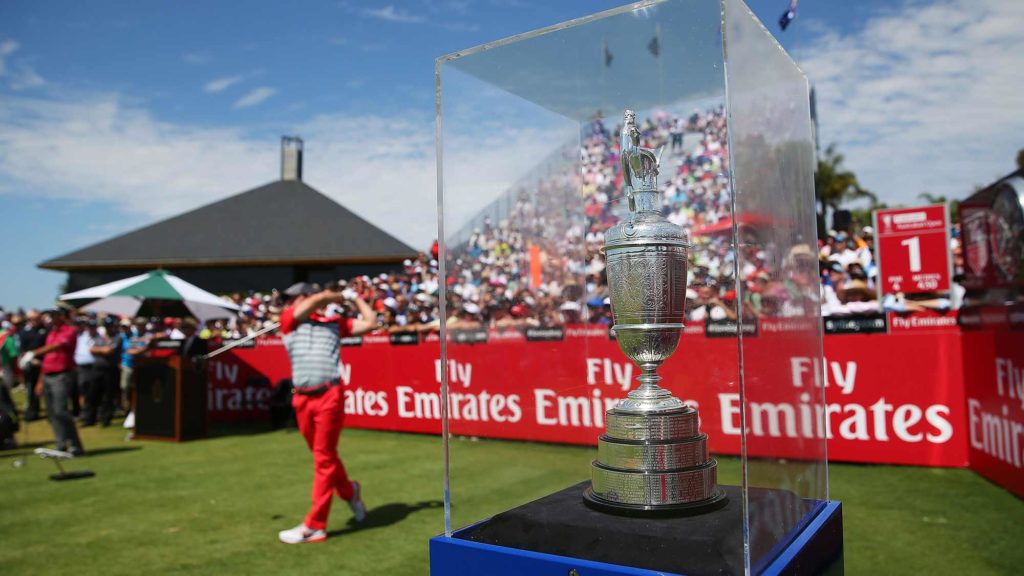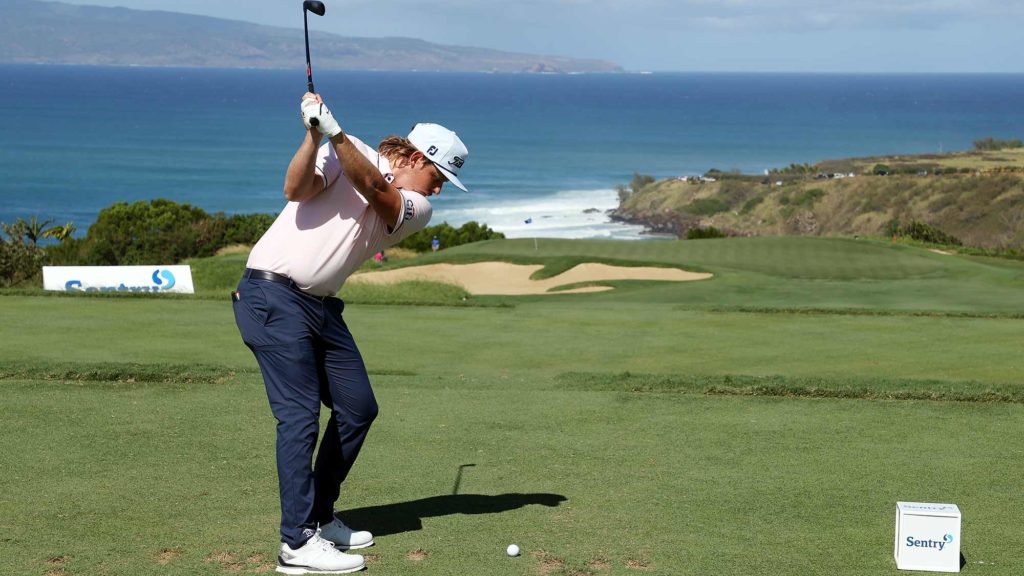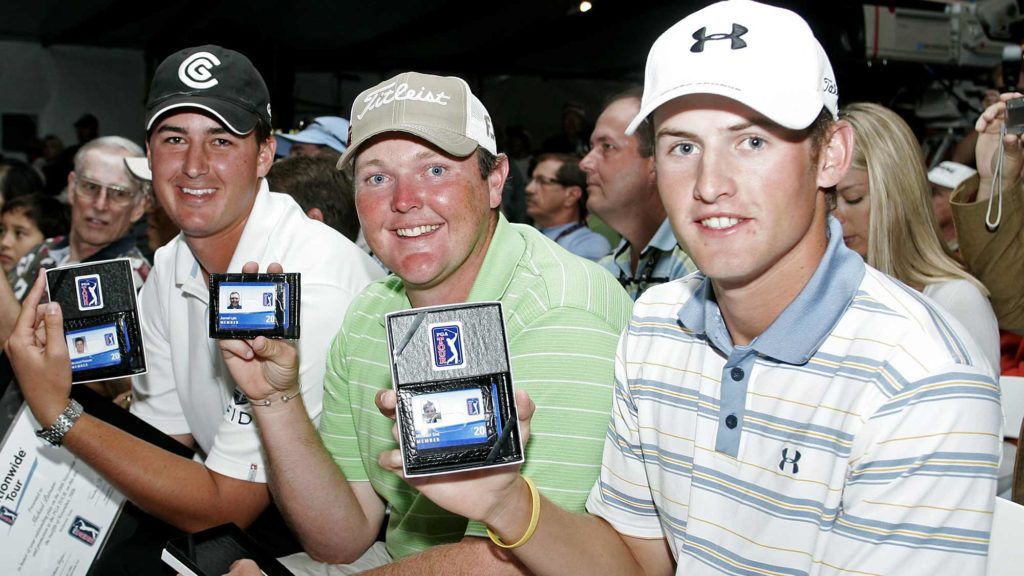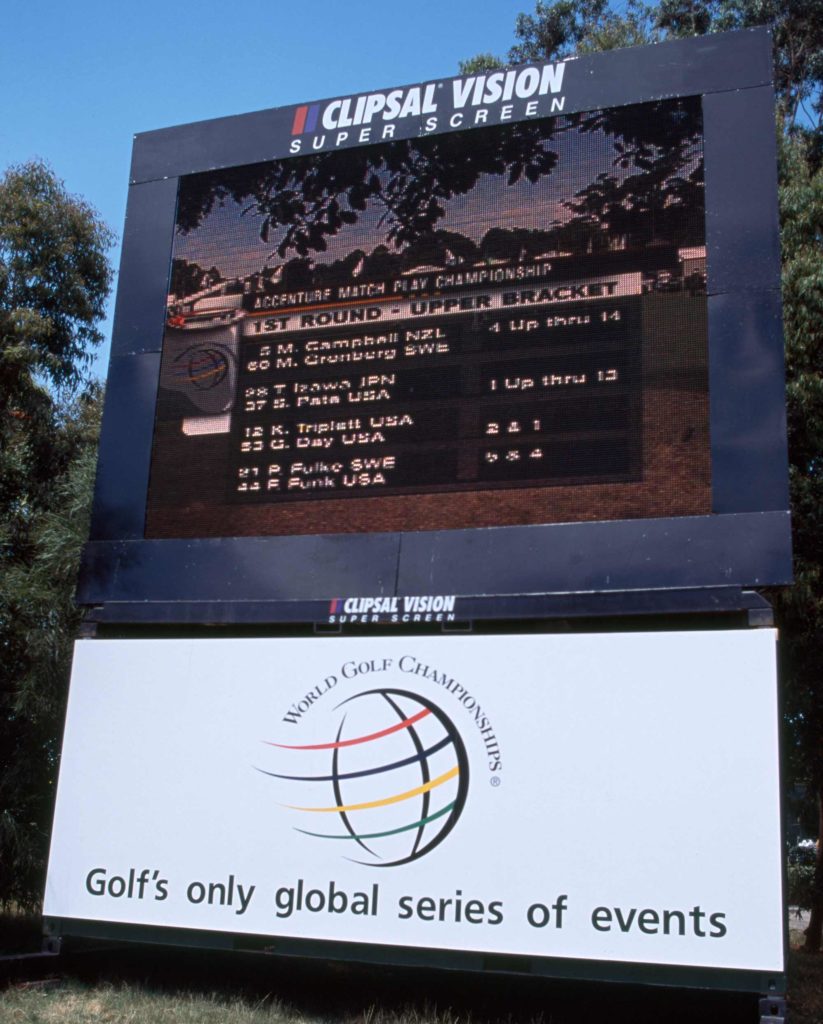A new take on a World Tour for golf would be one small step for the US, and one giant leap for Australia
It was sold as “a significant step for the global game”. And in some ways, it was. The PGA Tour’s new-look schedule for the 2021-2022 season was a step in the right direction – if you live in the northern hemisphere. But for Australian golf, it felt like another reminder that our island continent is still considered another world.
•••

The new schedule featured several interesting changes when it was announced in August. Notably, that the PGA Tour will co-sanction a European Tour event, the Scottish Open in July, for the first time. Secondly, that European Tour members will be given spots in, and be able to earn Race to Dubai moneylist points from, the Barbasol and Barracuda opposite-field events during the American summer.
A third change, though, was where Australian fans were right to feel the dream of hosting an annual, official PGA Tour event slipped even further away – the axing of two World Golf Championship events. The WGCs were sliced in half from four to two, with the WGC–FedEx St Jude Championship in Memphis, Tennessee, losing its WGC title (but being promoted to the opening FedEx Cup Playoffs event) and the WGC–Mexico Championship being demoted to a regular PGA Tour event. Now, only the Match Play event in Austin, Texas, and the HSBC Champions, in China, remain as WGCs – and the latter of those has been cancelled for a second year.
A WGC was Australia’s best chance at securing an official PGA Tour event, given the fact at least some of those exclusive, limited-field events, by nature, had to be held outside the US. It also helped that Australia once hosted the WGC–Match Play, at Metropolitan Golf Club in 2001. With that daydream now half as likely, it’s only fitting your writer attempts to make a case four times as compelling as any previous pitch for Australia to host an annual PGA Tour event. But that’s not all.

A ‘World’ Tour
This is not the first concept of a world tour, and it won’t be the last. But an idea with significant input from two-time Nationwide (now Korn Ferry Tour) winner Ewan Porter, as well as myself, a well-travelled PGA Tour reporter, might have some added plausibility.
The elevator pitch is this: a world tour, whose 200 members are the top 100 players from each of the PGA and European tours, which moves in windows around the world between January and August, including two events in Australia and one in New Zealand. Meanwhile, the European and Korn Ferry circuits act as feeder tours to the big dance. However, the Korn Ferry Tour is elevated to equal footing with Europe in prestige. How? By being condensed to 14 consecutive tournaments between September and December; by absorbing the PGA Tour’s sleepy autumn events; by giving one-year exemptions to the top five players from the previous year’s order of merit on the Australasian, Asian, Canadian, Japanese, Challenge (Europe), South American and South African (Sunshine) tours; and by having each event’s purse bolstered to $US2 million.

How it would work
The World Tour would, in year one, feature the top 100 players from the previous FedEx Cup (US) and Race to Dubai (Europe) rankings. Year two would see the top 100 World Tour players from year one keep their cards while the top 50 from the new Korn Ferry Tour and European Tour would be promoted. Consequently, the two feeder tours get strengthened from year two onwards by having World Tour players drop down.
The World Tour would kick off in January with the popular Hawaii swing of Maui and Honolulu, before heading to the Middle East for two events. In February, there’d be three stops in Asia before – wait for it – heading to our shores. Here, the Australian Open, Australian PGA Championship and the New Zealand Open would form a ‘Down Under swing’ that would conclude in early March. These events would be elevated enormously in stature by fielding the biggest stars in golf, but the downside would be not all of the rank-and-file Australian players would get a start. Some would be annoyed. However, 10 invitations would be given to the best Australian players, based on the Official World Golf Ranking (and Kiwis for the NZ Open), who are not already exempt. Meanwhile, our state opens and other Australian tournaments would be held before and after this swing. These events would also invite Korn Ferry and European Tour players to grace our fairways before they head back to Europe for an April start. It would be a huge boost for those state and city tournaments.
For Australia, this grand plan would ensure golf enjoys three-month window when cricket is its only real competition. (Tennis is in January, but it would not come up against the World Tour swing.) For three of those 12 weeks, the entire sporting world would be watching our courses and cities for the World Tour events. It would also give top players such as Adam Scott, Cam Smith and Marc Leishman an excuse to combine playing in Australia with an annual break in their homeland, but without falling behind in FedEx Cup points. Couple this with the LPGA Tour and Ladies European Tour, which already come here in February, and it would be a festival of golf not seen before Down Under.
But back to the World Tour, which would return to American shores in early or mid-March and remain there through unti late June. After Australia, it’d touch back in California for events such as Pebble Beach and Tiger Woods’ elite-field Genesis Invitational, and then include the biggest events on the US schedule like the Players Championship, Arnold Palmer Invitational, WGC–Match Play, the Masters, PGA Championship, Memorial Tournament, US Open and more.
The World Tour would then head across the pond for the Scottish and Irish Opens before The Open and then BMW PGA at Wentworth – a four-week golf party in the British Isles. In August, it’s back to the US for the trio of FedEx Cup Playoff events.

The case for a new Korn Ferry Tour
The Korn Ferry Tour would be one of the biggest winners out of this. While playing 14 weeks straight would be gruelling, the carrot dangling would be that the top 50, from year two, get cards on the World Tour, while getting demoted from the World Tour would not be such a kick in the guts given the new-look Korn Ferry would be a significantly more lucrative circuit than it was. The money saved by consolidating the World Tour could be reinvested in bolstering the purses of the Korn Ferry Tour, making it a legitimate place to earn a decent living.
The September-through-December window in US sports is incredibly competitive. American football, baseball and ice hockey reign supreme and the gut-punch for golf is that college sports are almost as popular as pro sports. Football’s biggest two days are Saturday (college) and Sunday (NFL) – just when a golf tournament is at its most watchable. During this time, very few “casual” golf fans are watching, so why not offer the Korn Ferry Tour as the only circuit that golf’s core fan base can watch at that time of year? Wouldn’t that be better than the Korn Ferry running against the PGA Tour from January to August and going largely unwatched? Some events on the PGA Tour’s autumn calendar could also be absorbed, such as the tournaments in Las Vegas and Mexico, and be given good treatment on the Korn Ferry schedule. A swathe of new, loveable stars would emerge. We’d have known who Harry Higgs was well before he made it to the PGA Tour. The benefit for the elite players of the world would be a proper offseason, which they can have off without falling behind on the FedEx Cup race.
In year one of the World Tour, the top 50 Korn Ferry players from the previous year’s moneylist would receive European Tour cards (instead of being promoted to the PGA Tour like they normally are) and they would play there from April to August.

Finally, a real global pathway
Perhaps the biggest intrinsic victory of all of this would be, like we mentioned in the elevator pitch, the Korn Ferry Tour would offer one-year cards to the top five players from the orders of merit on the Australasian, Asian, Japanese, Sunshine (South African), South American, Canadian and Challenge tours. Each Korn Ferry Tour event would simply add those 35 spots to their fields. The fields would be large for the first two days at Korn Ferry events, but that’s a small price to pay. Players from each of those seven tours would be given a clear and wider pathway to take their game from their homeland to the World Tour.
One Australian in favour of the idea, when this writer relayed it to him via phone, was tour player Michael Sim. Sim, and good friend Nick Flanagan, were the only two Australians to ever earn “Battlefield Promotions” to the PGA Tour from the formerly named Nationwide Tour. A battlefield promotion is a guaranteed card on the PGA Tour by virtue of winning three events in the same Korn Ferry season. Flanagan pulled it off in 2007, two years before Sim copied his mate by winning the Stonebrae Classic, BMW Charity Pro-Am and the Christmas in October Classic. Scotland-born West Australian Sim managed to crack the world’s top 50 that year before he joined the PGA Tour in 2010, which is unheard of. At the 2009 US Open, he played with Tiger Woods in the final round at New York’s famous Bethpage Black course.
While what Flanagan and Sim achieved was almost inconceivable, the more routine way to get to the PGA Tour was to finish in the top 25 on the Nationwide Tour’s moneylist. Australians and Kiwis were given a better chance at doing so when, during several years in the mid-2000s, Australia and New Zealand held various tournaments co-sanctioned with the Nationwide – including the Jacob’s Creek Open, Moonah Classic, NZ PGA Championship and NZ Open. With those now gone, the only pathways are that the winner of the PGA Tour of Australasia order of merit receives a one-year exemption on the European Tour, while the winner of the Australian PGA Championship, via co-sanctioning with Europe, gets a two-year card there.
“I got my career started by playing [those co-sanctioned events] in Australia and they don’t have those Korn Ferry events anymore,” Sim tells Australian Golf Digest.
“A lot of us got started that way; Flanagan, Paul Sheehan, Brendan Jones (now a Japan Tour stalwart), Bowdo (Steven Bowditch), Pricey (Aron Price), and (Marc) Leishman. They are just some of the Aussies who made it that way, but there are a heap more. I think any time you can give internationals a chance, I think it’s a good idea.
“[In terms of this article’s World Tour concept] well, it is sort of trending in that direction, slowly. [The PGA Tour] has acquired the PGA Tour China, LatinoAmerica and Canada. The only tours they don’t have are Asia and Australia. So, who knows what’s going to happen in the next five or 10 years?”
Well, this writer has a suggestion.

Aussie watch
Which Australians qualified for the 2021-2022 PGA Tour season – and where they can win
CAMERON SMITH
AGE: 28
WORLD RANKING: 23
PGA TOUR WINS: 3
BEST TROPHY CHANCE: The Masters
LOOKING AHEAD: The Mullet King is primed for a Major win in 2022 after a PGA Tour season highlighted by a win, two runner-up finishes and lots of other chances. Second at the November 2020 Masters and T-10th in 2021. Watch the ‘Hair Apparent’ take off in 2022.
ADAM SCOTT
AGE: 41
WORLD RANKING: 39
PGA TOUR WINS: 14
BEST TROPHY CHANCE: Farmers Insurance Open at Torrey Pines
LOOKING AHEAD: Scott began to see flashes of his brilliant best in 2021, with a second place his best result, after hardly playing during the pandemic-halted 2020 season. Should he choose to play Torrey Pines again, he is a big chance to add to Australia’s win tally in San Diego after a second and T-10 in his only two career starts in the PGA Tour’s regular event there.
MARC LEISHMAN
AGE: 37
WORLD RANKING: 38
PGA TOUR WINS: 6
BEST TROPHY CHANCE: Sony Open in Hawaii
LOOKING AHEAD: Big ‘Leish’ is still working hard to get his world-beating game back and it is close. He turned a corner in 2021 with four top-10s. After so many career chances to win at Waialae Country Club, watch for the big fella from windy Warrnambool to finally get the job done in Honolulu.
LUCAS HERBERT
AGE: 25
WORLD RANKING: 52
PGA TOUR WINS: 0
BEST TROPHY CHANCE: Scottish Open
LOOKING AHEAD: The boy from Bendigo came up clutch with a birdie on the last hole at the Korn Ferry Finals opener in Idaho to secure promotion to the PGA Tour. The former European Tour player is approaching the top 50 in the world courtesy of winning the Irish Open this year, so watch him win the Scottish Open now that it will be a PGA Tour co-sanctioned tournament.
CAMERON DAVIS
AGE: 26
WORLD RANKING: 64
PGA TOUR WINS: 1
BEST TROPHY CHANCE: World Wide Technology Championship at Mayakoba (Mexico)
LOOKING AHEAD: Davis scored his maiden PGA Tour victory this year and it appears his second is a big chance of happening at the Mayakoba event in Mexico, where he tied for 15th on his PGA Tour debut in 2016, and where he led Australia to a 19-shot win at the World Amateur Teams trophy earlier that year.
MATT JONES
AGE: 41
WORLD RANKING: 75
PGA TOUR WINS: 2
BEST TROPHY CHANCE: AT&T Pebble Beach Pro-Am
LOOKING AHEAD: Sydneysider Jones bagged his second career PGA Tour win at the challenging Honda Classic this year. His third title should be at the Pebble Beach Pro-Am, where he’s had three career top-10s. He wouldn’t look out of place holding the trophy aloft on Pebble Beach’s iconic 18th hole.
JASON DAY
AGE: 33
WORLD RANKING: 78
PGA TOUR WINS: 12
BEST TROPHY CHANCE: Travelers Championship
LOOKING AHEAD: The former world No.1 is still struggling to find his once dominant form after just three top-10s and nine missed cuts last season. But he’s still only 33 and he will return to the winner’s circle, probably at the Travelers Championship in Connecticut – where he’s got a nice little record including a T-10 last season.
BRETT DREWITT
AGE: 30
WORLD RANKING: 345
PGA TOUR WINS: 0
BEST TROPHY CHANCE: Bermuda Championship
LOOKING AHEAD: Drewitt secured a return to the PGA Tour from the Korn Ferry regular season’s top-25 moneylist, after playing more than 40 tournaments. If he doesn’t claim the season-opening event in the Napa Valley, where he tied for 25th in 2019 while on his honeymoon, his best chance to win could be against a lesser field in Bermuda.
Feature image by Getty images: Richard Heathcote



